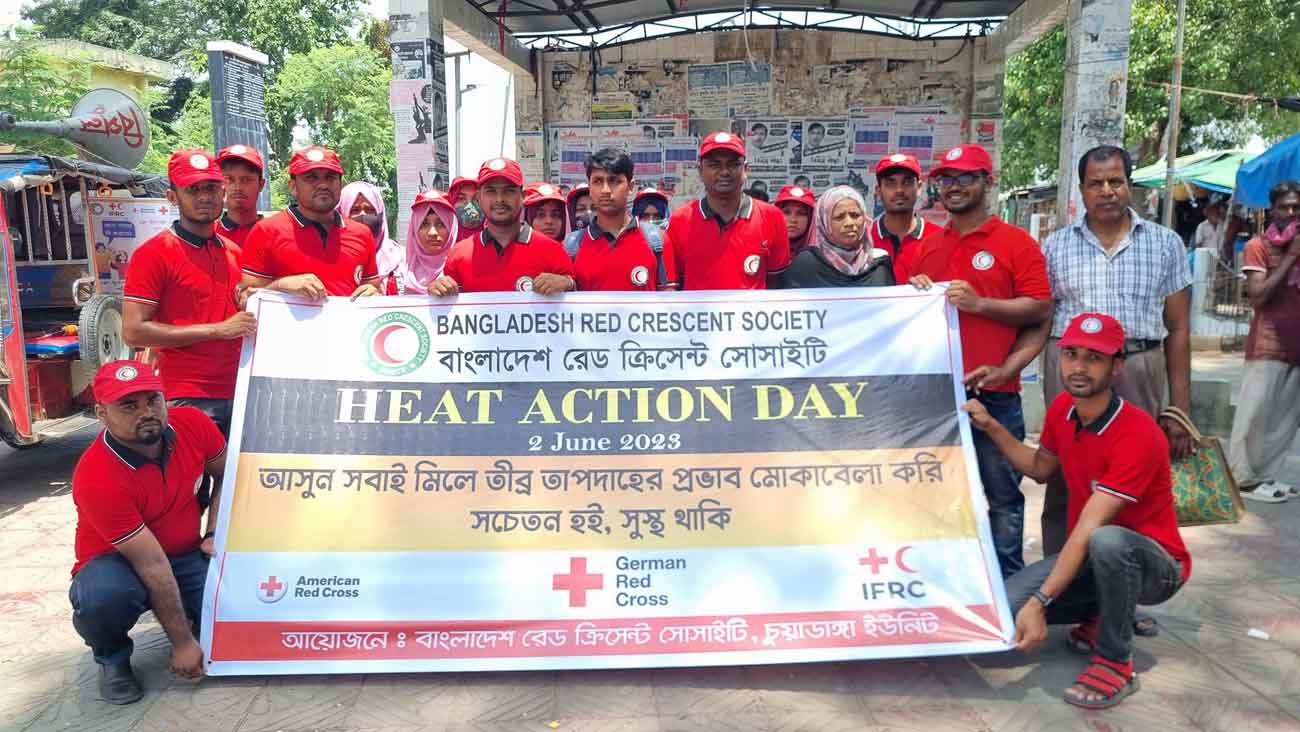
By Colin Fernandes, Preparedness Lead; and Manish A. Tewani, Response Lead; Asia Pacific Division, American Red Cross, Thailand

It is an established fact that climate change is exacerbating extreme heat and heatwaves will increase. According to the Sixth Assessment Report of the Intergovernmental Panel on Climate Change (IPCC), human-caused climate change has increased the frequency and intensity of heatwaves since the 1950s and additional warming will further increase their frequency and intensity. The report also states that, with high confidence, heatwaves in cities have intensified and impacts will be concentrated amongst economically and socially marginalized urban residents, e.g., those living in informal settlements and urban poor. Heatwaves are also expected to add pressure on urban infrastructure and systems, especially energy, water and health[1].
There is an urgent need to reduce emissions, end our dependence on fossil fuels, and ramp up renewable energy sources. Even with this scenario, there would still need to continue preparing and coping for extreme heat events and heatwaves. It is estimated that 74% of the global population will be exposed to lethal heatwaves worldwide by 2100 if carbon emissions continue to increase at existing rates[2]. Heat is considered a “silent killer” because it is and can be deadlier than all other disasters, yet it leaves behind no visual clues as to the scale of its devastation. In 2022, several geographic regions experienced heatwaves such as India-Pakistan (2022), which stressed energy supply[3], while Japan experienced it worst heatwave in 150 years[4].
In recent years, there has been immense advancement in technology for improving weather and climate modelling and forecasting, which should have a cascading effect on reducing fatalities from heatwaves. There is necessary innovation and technology that is able to give more accurate and even hyper-local information and forecasts on weather, but this information is only effective when it can be transformed into understandable, contextualized, actionable messaging which is accessed easily. These principles were enshrined as early as 1997 during the International Decade for Natural Disaster Reduction[5].
The Red Cross Red Crescent Movement is the world’s largest humanitarian organization and is cognizant of this and has been taking relevant steps to ensure that its National Societies have the relevant knowledge, tools and resources to prepare for and respond to such events. National Societies have responded to extreme heat events particularly to support affected vulnerable communities in several countries such as Bangladesh, Indonesia, Nepal, and Vietnam, to name a few. In addition to helping people with cool/weather-controlled shelter, drinking water, transportation to medical facilities. National Societies in several countries have finalized or are working on Early Action Protocols (EAPs) for extreme heat events. Such EAPs will enable the National Societies to implement anticipatory action and therefore reach the most vulnerable parts of the community before the negative impact of heatwaves materializes.
As mentioned in the IPCC report, the most vulnerable and with the least resources will be impacted the most – so how do we protect those who will be the most affected? There needs to be a holistic societal approach to address this need by working across policy, practice, and program levels. Cities need to plan or replan differently, increasing their green coverage or stopping the conversion of green spaces for lucrative real-estate development, which could benefit a tiny proportion of the population. There is an increasing number of cities which are revitalizing green spaces within their urban plans which not only helps in temperature reduction but also increases biodiversity and has a positive impact on mental health. Cities are developing their Heat Action Plans, supported by Red Cross Red Crescent National Societies and other stakeholders in Nepal, Bangladesh, and Vietnam.
Social legislation, which has a strong focus on social protection for the most at-risk members of our society, is another key strategy for reducing heat impacts. Housing, livelihoods and health are some issues the economically and socially marginalized sections face, which will further worsen with heatwaves. Affordable housing programs with corresponding information and technical support need to be devised that would assist low-income households in improving their housing condition and reducing indoor temperature. Attention should also be given to culture and context-specific design and materials used in such housing programs, so they are better adapted to local climate and increasing temperatures. Similarly, access to equitable health care services should be scaled up as cases are expected to grow due to increasing temperature, especially among vulnerable groups[6]. Government and non-profit organizations should design new programs and services that provide critical and urgent healthcare solutions for affected populations in urban areas. Education curriculum and First Aid modules need to integrate the issue of heat and ways to combat it that will contribute to creating a culture rather than a seasonal reaction. Greater awareness among the population on recognizing an extreme heat event, preparedness measures for dealing with such an event and response actions to help those affected by extreme heat will be achieved by the continued and expanded spread of these integrated education curricula and first aid training.
It is said that earthquakes do not kill people, but badly constructed buildings do; the same corollary should be used for heatwaves—they should not kill when we have the necessary measures and protection in place.
[1] Synthesis Report of the IPCC Sixth Assessment Report (AR6) https://report.ipcc.ch/ar6syr/pdf/IPCC_AR6_SYR_LongerReport.pdf
[2] Urban climate risks and the role of social protection https://www.climatecentre.org/wp-content/uploads/RCCC_Urban-climate-risks-briefing-note.pdf
[3] India sweats over worst power cuts in six years during extreme heat https://www.reuters.com/world/india/indian-heat-wave-disrupts-industrial-activity-power-demand-soars-2022-04-28/
[4] Japan swelters in its worst heatwave ever recorded https://www.bbc.com/news/world-asia-61976937
[5] Guiding Principles for Effective Early Warning https://www.unisdr.org/2006/ppew/whats-ew/pdf/guiding-principles-for-effective-ew.pdf
[6] Heat and Health https://ghhin.org/heat-and-health/